High Speed DDR2: Buffalo and Crucial Deliver 1000+
by Wesley Fink on July 7, 2006 12:05 AM EST- Posted in
- Memory
DDR2 533 (1:1) Performance
The DDR2-533 memory speed is important with a 1066 FSB CPU because it represents 1:1 memory performance. On Intel platforms the memory controller is still a part of the chipset and not on-processor as it is on the AM2. As a result you would generally expect the fastest relative memory performance possible on an Intel board by running the memory at a 1:1 ratio.
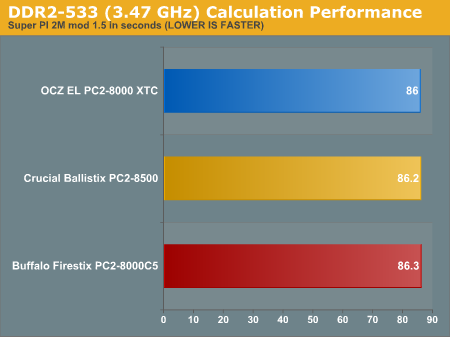
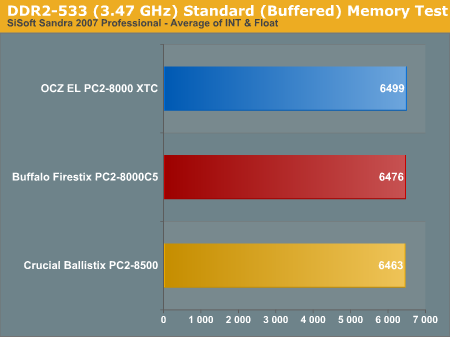

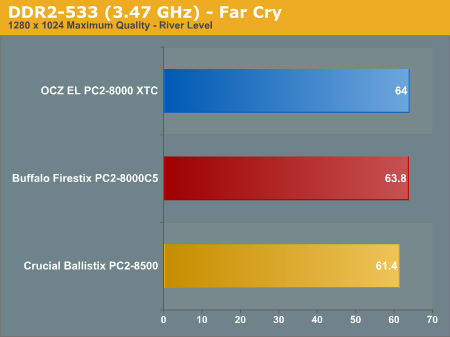
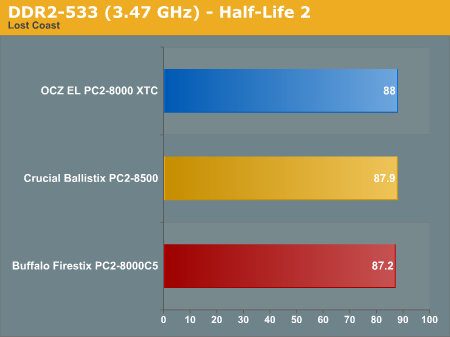
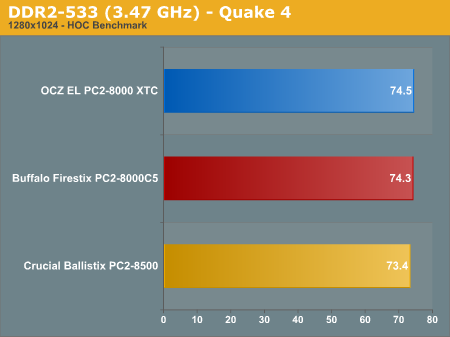
The OCZ EL PC2-8000 is able to run the important 1:1 memory ratio at the fastest settings possible on the Asus board. The ability to run 3-2-2 timings at this speed is reflected in chart-topping DDR2-533 performance. The Crucial and Buffalo DDR2-1000 are nearly as fast at 3-2-3 timings at DDR2-533.
The DDR2-533 memory speed is important with a 1066 FSB CPU because it represents 1:1 memory performance. On Intel platforms the memory controller is still a part of the chipset and not on-processor as it is on the AM2. As a result you would generally expect the fastest relative memory performance possible on an Intel board by running the memory at a 1:1 ratio.






The OCZ EL PC2-8000 is able to run the important 1:1 memory ratio at the fastest settings possible on the Asus board. The ability to run 3-2-2 timings at this speed is reflected in chart-topping DDR2-533 performance. The Crucial and Buffalo DDR2-1000 are nearly as fast at 3-2-3 timings at DDR2-533.










24 Comments
View All Comments
Wesley Fink - Monday, July 10, 2006 - link
Crucial has advised AnandTech that "all of Crucial's memory products come with a lifetime warranty". We have updated the review to reflect this information on the Crucial warranty.MacGuffin - Saturday, July 8, 2006 - link
It should read DDR2 1067 (1:2) Performance.
This needs to be fixed on Page 10, along with the link on Page 9 that points to page 10, and the Article Index drop-down list.
Excellent Review, nonetheless.
JarredWalton - Saturday, July 8, 2006 - link
Fixed, thanks. :)PLaYaHaTeD - Saturday, July 8, 2006 - link
I thought since the front side bus of the 965 is 1066, it would be the 'Holy Grail' to have the memory running at 1066 as well. Wouldnt this make it synchronous again? What am i missing?MacGuffin - Saturday, July 8, 2006 - link
Synchronous Operation (meaning FSB:DRAM Ratio at 1:1)266MHz FSB -> 266MHz RAM Speed -> 533MHz DDR2
The 1:2 Divider (which isn't synchronous) yields 1066MHz
266MHz FSB -> 533MHz RAM Speed -> 1066MHz DDR2
Am I right or have I gotten it wrong? I haven't used Intel since I got this Socket 754 I am typing on.
poohbear - Friday, July 7, 2006 - link
hello, just wanna clarify if the a64 can actually use any of the extra bandwidth provided by ddr2 800+? is it only for bragging rights or is the a64 actually saturated for memory bandwidth & therefore this higher bandwidth provides performance improvements? thanks in advance.Wesley Fink - Friday, July 7, 2006 - link
The A64 does exhibit tremendous DDR2 bandwidth with the on-chip DDR2 memory controller, and memory bandwidth continues to improve as speed goes up. However, as we found in our testing of the AM2 in the DDR2 vs. DDR article, the AM2 design is not memory bandwidth starved, and the extra memory bandwidth makes almost no difference in real-world performance on the current AM2 platform. The improved memory bandwidth may make more of a difference in future AM2 designs.lopri - Friday, July 7, 2006 - link
I thought this issue was mentioned in the article but I couldn't find it when I re-read it. I know on intel system the memory running slower than 1:1 will result in small penalty, but how about memory running faster than FSB? I vaguely remember that I've heard somewhere it's better than 1:1 cause that way memory "pushes" or "rushes to" FSB. Another theory I've heard is that faster memory can make up for possible performance loss on FSB subsystem, leading to less CPU idle time. According to this review, regardless the ratio, the performance seems to increase linearly to memory speed increase.So the questions being:
1. Is 1:1 the most ideal ratio without "waste"?
2. Or a slightly higher memory speed than FSB (such as 4:5) better than 1:1, preventing possible CPU idle time and "pushing" the data at the same time?
3. Or under the same CPU/FSB speed, the faster the memory the better the performance - indefinitely, taking advantage of faster memory speed?
I would think No.3 doesn't make sense because of the very FSB. In the end the FSB has been what's limiting both CPU and memory on Intel system. How could the performance get benefit from 3:5? In an ideal world there should be waste of 2. (5 - 3 = 2) Is the performance even better with 1:2? I can't imagine the FSB system being only 50% efficient, but is that the case?
Gary Key - Saturday, July 8, 2006 - link
Lopri,Please email me about this subject. Short story is 1:1 or 4:5 are your best ratios for the Intel platform at this time although this will change depending your choice of Conroe model. We will go over this in more detail shortly and I will respond here further once I complete some article testing.
Thanks,
Gary
Locust - Friday, July 7, 2006 - link
Very good article, but I have a question. How come you guys did not review Corsair's PC8500 memory modules. I have been using 2GB kit(2x1GB) for over a month and getting timings comparable to OCZ's. DDR2 800 runs at 3-3-3-5 memory settings on same mobo.Best si DDR 1000 @ 4-4-3-8 @ 2.2 recommended voltage.
Good to see more vendors offering these memory speeds, now let's just hope prices will get under $400 :-)